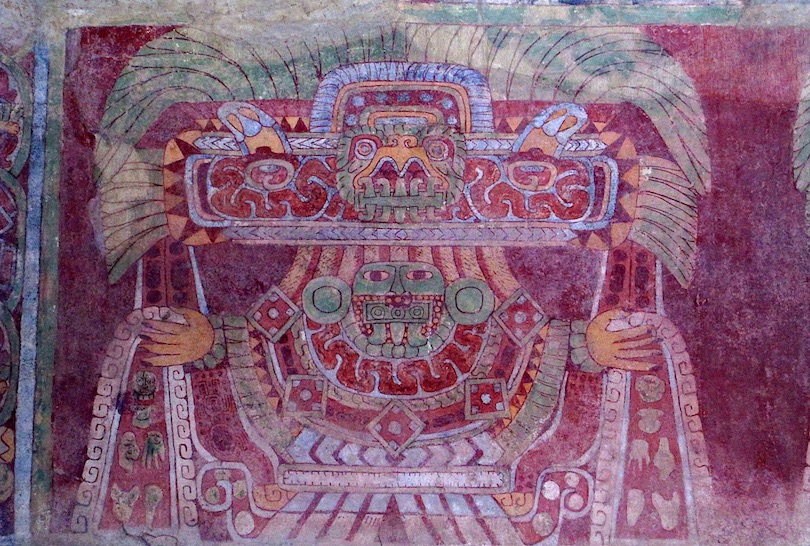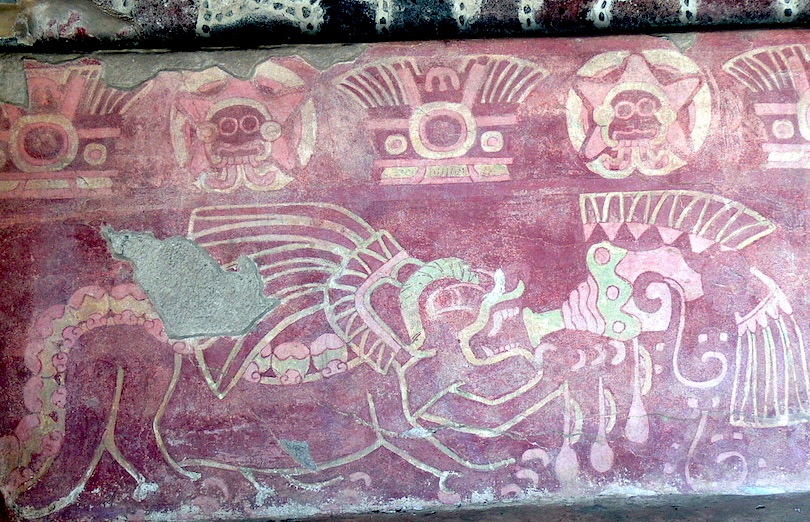Do you like history? No, not boring pages in the textbook. A real one that you can practically touch. To see how they lived, what they thought and what the ancient people believed. To do this, you need to have a time machine, just visit one of the oldest cities in the world Teotihuacan in Mexico. People lived in it long before the advent of the famous Aztecs. The city had water supply, the necessary amenities of that time, numerous religious temples. But at one point the residents left him, leaving their property.
Location
Teotihuacan is located near Mexico City, just 50 km northeast of the city center. Numerous excursions are organized there, so getting there is not difficult.
How to get there
You can get there by public transport by bus from the bus station. Just make sure that the bus goes to the main entrance to Teotihuacan, not the nearby settlement.
Independent travel by car is quite expensive. You can get there by a toll motorway from the center of Mexico City (there are signs everywhere), or by a regular road. But the trip takes at least an hour. In addition, parking near Teotihuacan is paid. Traveling by taxi is also very expensive.
Sightseeing buses are the most preferred option. Excursions can be for the whole day, or half a day. You will be accompanied by a guide, organized visits to attractions with the provision of entrance tickets.
Basic Information about Teotihuacan
Teotihuacan was one of the most populated and developed cities of the Mesoamerican period. Scientists believe that more than 150 thousand people lived in it, and the city was multi-ethnic. It was mainly inhabited by the Nahua, Otomi and Totonaki tribes. In addition, there were many migrants: skilled workers and laborers from different parts of pre-Columbian America.
The first settlement in this place arose in the 3rd century. BC e., but the city appeared only in the 2nd century. n e. Teotihuacan was one of the largest cities in its heyday, one of the six largest cities in the world. However, in the 6th century. n e. it fell into decline and by the beginning of the 7th century. all the inhabitants left him. Why this happened, scientists can’t say for sure. Found an abandoned city, or rather its ruins, the Aztecs, after several centuries. It was they who gave the name to the city and all its attractions.
Now a museum is open in Teotihuacan. It contains more than 600 objects of religious and cultural significance and artifacts. The panoramic picture of the ancient city was reconstructed, thanks to which the greatness of Teotihuacan was recreated.

Features of the construction of the city
Unlike most ancient cities, Teotihuacan was not built chaotically. Even today, the location of streets intersecting at right angles with the main avenue is clearly visible. In the center are religious buildings and houses of nobility, and around - the dwellings of ordinary citizens, which form entire neighborhoods. All this indicates the planned development of the city.
In the heart of the city is the citadel - an area that accommodates almost half of the inhabitants. It is limited by 4 large pyramids on the platforms. In the center is the pyramid of the Feathered Serpent (Quetzalcoatl), the main deity of the inhabitants. On both sides adjoin buildings that were used as administrative centers and apartments for the nobility.
The houses of the townspeople were mostly single-story with a flat roof and had no windows. Light and air penetrated only through the front door.There were also multi-story buildings, but there were few of them.
Of particular importance are religious temples and pyramids. The city is practically strewn with occult constructions mainly in the center and on the main streets. No wonder the second name Teotihuacan bears the "city of the gods."
Cultural significance
In its heyday, approximately 250-660 years. n e., Teotihuacan was one of the most prosperous cities of pre-Columbian America. It was developed trade, craft, agricultural business. The city had a significant impact on many areas of Mesoamerica. Household items, jewelry, home tools made in Teotihuacan, archaeologists found in remote regions of Latin America.
Teotihuacan maintained contact with neighboring developed states, such as Maya and Monte Alban, and also held power over part of the small settlements in the territory of modern Mexico.
City government and religion
By design, Teotihuacan can be considered a modern city-state. Power belonged to the corporate elite. Her task was economic and political development. The priests had power over the townspeople. They determined the time of sowing and harvesting, monitored public life. Thanks to religious pressure through human sacrifice exercised social control.
All the inhabitants of Teotihuacan were very religious. Home altars, statues of deities were in every house, including the poorest. Religious holidays and ceremonies were held regularly. Many believed in their mystical destiny. On special occasions, the entire city and the surrounding villages were practically empty - all the inhabitants were in churches at religious ceremonies.
The death of the city
Despite its greatness and prosperity, Teotihuacan was destroyed. Why this happened, scientists do not know. Decline began in the 6th century. n e., and in the 7th century. n e. all the inhabitants simply left the city, leaving its wealth and acquired property.
There are two main hypotheses: famine and military invasion. Many researchers are skeptical of a military takeover, as there is little evidence of this in the ruins of the city. But the death of a thriving city-state due to natural disasters is quite likely.
At that time, several major volcanic eruptions occurred on the continent, as a result of which the climate changed. There was a long drought. Artifacts and surviving murals indicate a lack of nutrition, people almost died of hunger. There was a split at the top of the government, and the city actually lost control. It is possible that there were military offensives or civil war, which aggravated the situation of Teotihuacan. As a result of all the events, people simply left the dying city in search of a better place to live.
Teotihuacan - city of the gods
At the dawn of mankind, paganism was widespread. People worshiped the natural elements, inexplicable phenomena. They performed various rituals and sacrifices to appease the gods. The main goal is to get a good harvest, have plenty of drinking water and no epidemics.
Teotihuacan can be considered the city of the gods. On its territory a huge number of temples, altars, religious buildings, frescoes with the image of occult rituals and mystical pyramids. Most of them are well preserved to this day, are of historical and cultural value.
The palaces of Tetitl and Atetelko are considered the residence of priests. There are numerous frescoes telling about the life of people of that period. They depict people picking flowers, and falling water means an artificial irrigation system that was built in the city. Captured moments of human sacrifice, which were not uncommon at that time. The image of people of different colors indicates the class inequality of the inhabitants.

Particular attention is drawn to the Great Goddess or Spider Woman in a headdress with an image of an owl, which is framed by a snake.She is considered the patroness of the crop and land.

The palace of the jaguars is of particular importance. It features frescoes representing military operations and human sacrifices. It is possible that meetings of priests and supreme rulers took place in it, at which the fate of the city, its development, military offensives and the like were decided.

Quetzalpapalotl Palace is the most luxurious building of Teotihuacan. Its walls are decorated with carved columns, painted lintels and frescoes. It is believed that the rulers of the city and, possibly, the high priests lived in it.

The Temple of the Feathered Serpent (Quetzalpapalotl) is the smallest of the three pyramids of Teotihuacan. It is located on the main square of the city. Pyramid vaults adorn the head of a serpent with feathers, as a symbol of the central deity.

Alley of the Dead is the main street of the ancient city. The alley has nothing to do with burials. Just the embankments on both sides look like tombs that served to perform rituals. The length of the street reached several kilometers, but a small part of it was restored. But passing through it, you can feel the former power and grandeur of the city.
The Pyramid of the Moon is located in the north of the Walk of the Dead. She is considered the hallmark of Teotihuacan. It was built between 200-250 years. n e. Burials were found under the pyramid. Perhaps it was used as a tomb. Also found numerous remains of skeletons of people and animals, jewelry, household items and other artifacts. Scientists believe that it was here that ritual sacrifices were performed.

Pyramid of the Sun - the largest and most magnificent pyramid of Teotihuacan, its height is 75 m.

Once it was painted bright red, and the arches were decorated with a variety of frescoes. At the top is the altar. Although no remains of animals or people have been discovered, archaeologists do not exclude that sacrifices were made there. Perhaps, also, she served as a tomb for the authorities.

Unfortunately, the Pyramid of the Sun is greatly destroyed, and it is difficult to draw conclusions about its true purpose. It is believed that her main task was reduced to astrological observations and predictions.
